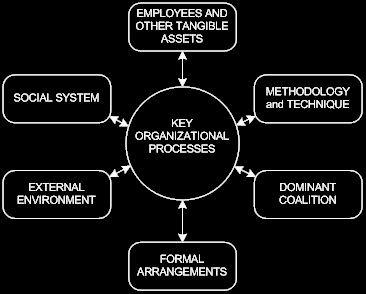|
1. Cause-and-Effect Relationships
In the short run, the most important relationships among the elements in the model are those of a cause-and-effect nature that connect the key organizational processes with the other elements.
Six structural elements provide the context in which the organizational processes emerge and run.
Each element is able to shape one or more key processes.
At the same time, the key processes have an impact on all six other elements. The processes help either to maintain or to change their states.
Furthermore, a structural element or its change will have an impact on a key process that in its turn will have an impact on one or more other elements.
In analysis of how any single structural element shapes the key processes, it is critical to consider a possible impact of the other elements as well.

2. Organizational Processes Effected by Structural Elements
In the short run, one of the directions of cause-and-effect relationships is the way how structural elements influence the key organizational processes.
The elements represent states of an organization. Change in any given state has an impact upon one or more key processes of the organization.
Examples of How Structural Elements Influence Key Processes
1. External Environment: A strike in the steel industry interrupts the inflow of steel parts into the company’s manufacturing process.
2. Dominant Coalition: The president retires, and a very different type of individual is elected to succeed him, causing significant changes in the leadership processes within the company.
3. Formal Arrangements: A new compensation plan for salespeople creates a significant expansion of activity in the company’s selling process.
4. Employees and Other Assets: An increase in the educational level of the corporate financial staff causes an improvement in the quality of the financial analysis process.
5. Internal Social System: An increase in the level of trust between members of production and sales units causes a significant increase in information sharing for the new product development process.
6. Techniques: The introduction of a new production control technology completely changes the nature of the production planning and control processes.
3. Structural Elements Effected by Organizational Processes
Possible influence relationships in the opposite direction find place when the key processes have an impact on the structural elements.
Various management disciplines are oriented toward shaping the organizational processes (that is, gathering information, making decisions, transporting and converting matter and energy) so that the processes have some impact on one or more structural elements in the model.
Examples of How Key Processes Influence Structural Elements
1. External Environment: A change in the advertising process causes demand for a certain product to increase 25 percent.
2. Dominant Coalition: A new reporting process for top management which supplies them with more and different information about the firm’s operations, causes their opinions about certain problem in the company to change considerably.
3. Formal Arrangements: A job evaluation process causes 10 percent of middle-level to be redesigned.
4. Employees and Other Assets: When a great deal of bitter conflict emerges in one of decision-making process, it immediately causes the job satisfaction of the people involved to go down.
5. Internal Social System: A new grievance process causes the relationships between workers and management to improve.
6. Techniques: The research and development process causes the continuous expansion of the firm’s core techniques and approaches.
4. Energy Required for Changes
Some managers and organization specialists seem to underestimate the amount of energy that must be mobilized in a process in order to produce a change in some structural element in a short period of time.
Not all the changes require considerable energy. But those changes in structures that are generally considered to be in a “positive” direction, from organization’s point of view, tend to require significant energy expenditure. As a result, it is quire possible for an organization to be in a position where it simply does not have the surplus matter/energy to make any number of changes that are ideally desired.
5. Summary
The key system dynamics concerning the short run are of a cause-and-effect nature between the structural elements and the organizational processes.
The six structural elements shape the key organizational processes.
At the same time, the key processes continuously affect the structural elements in ways that help maintain or change their states.
To predict an organization’s behavior over a short period of time, it is therefore important:
1 – to possess information on the states of the elements in the model;
2 – to have understanding of the two different types of cause-and-effect relationships involved.
The better the information a manager has on the states of the elements, and the better the manager understands those cause-and-effect relationships, the better the manager can account for and predict the system’s behavior over the short period of time.
Questions for Understanding or Predicting Dynamics in the Short Run
1. What is the current state of the following:
a. The organization’s key processes;
b. Its dominant coalition;
c. Its formal arrangements;
d. Its employees and other tangible assets;
e. Its social system;
f. Its methodologies, methods, approaches, and techniques;
g. Its external environment.
2. What, if anything, is currently changing or might change in the near future?
3. Given your understanding of short-run cause and effect, how do you think each change would immediately affect the key process (if it were a structural change) or each structural element (if it were a process change)?
4. What would be most likely to happen next? And then next? Trace the interaction of processes to structures to processes until the system achieves equilibrium and stops changing, or at least for a period of time of three to four months.
|